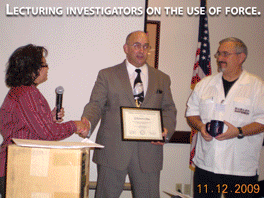
For some time now, the news media has inundated the public with stories of prison underfunding, poor prison health care, and the possibility of California releasing thousands of prison inmates to ease overcrowding. Additionally, two major prison riots were reported. One riot was in California and one in Kentucky. Numerous prisoners were injured and millions of dollars in damage was done during both riots. The news reported that prison overcrowding was to blame in each case.
During my 30 years in law enforcement I have led emergency response teams to quell over 100 large inmate disturbances (what many would call riots) in several very large, violent jails. I have taught other supervisors and line personnel how to handle such riots, and I have lectured on this topic in other states. And, even though I have retired, I am still involved with jail and prison issues by working with the Dr. Prison (www.drprison.org) organization. Dr. Prison counsels individuals who are going to be incarcerated for the first time how to survive by learning the rules of jail or prison.
Jail and Prison Riots
For once I would like to see the media report the full story about why jail and prison riots occur. To be fair, I do not know the actual cause of these two riots; however, based on my experience I can tell you what may have really happened and why.
Of course overcrowding adds to the problem. It adds to the stress the inmates feel. It means fewer inmates can get the proper health care they need, and there are fewer opportunities for the inmates to attend school, etc. Overcrowding places heavy burdens on the staff as well. It is a serious matter. But there is so much more going on in a riot.
This is what I can tell you about jail and prison riots based on my training, knowledge, and experience. Please note that I do not differentiate between jail and prison, as it is not necessary.
Whenever you place criminals together in jail, they are going to fight each other at some point. For the most part, people in jail are mean, ugly, violent people who have very little regard for others -- not all of them, but most of them. A great number of inmates in jail and prison will fight and damage what they can.
Some of the reasons inmates riot are power issues between races, revenge for an assault/killing on the streets, showing disrespect to others, stealing from each other, being ordered to riot by the prison gang leadership, and power over who controls the drugs and other contraband such as cell phones and cigarettes, just to name a few. When I talk of disrespect, I’m not talking about forgetting to say please and thank you. I’m talking about failing to use the “right” toilet, walking through someone’s personal space, using the “wrong” telephone, not cleaning up your assigned space, speaking with someone of another race, not standing up for your own race, and so on.
It is a fact that to get along in jail or prison, you must stick with your own race. If you are in an area where there is rioting, you must participate to show respect to your race. If you have an opportunity to join in the riot and do not, you run the risk of getting a beating, or being sexually assaulted later on. In one of the large jails I was assigned to, some of the gang leaders would order a beating called, “30 seconds under the stairs.” That means you would be pummeled for 30 seconds under the stairwell in the dorms. Thirty seconds is a very long time to suffer a beating. Look at your watch for 30 seconds and think about how your face can be mashed into pulp in that time. The staff may see what is happening and come to your aid, but it will take at least that long to get back up, open the door, and run to you.
I’m often asked which is more dangerous, and which is harder time -- jail or prison. In my opinion and in the opinion of hundreds of inmates I’ve spoken with, hands down, jail is more dangerous and the time is much harder to serve. The reason for this is that in jail there is a very good chance young, non-violent inmates with little jail savvy will be housed in the same area with hardened, experienced, violent inmates who do not hesitate to take advantage of the uninitiated and vulnerable. Persons entering jail and prison for the first time have no idea how to act. They haven’t the slightest clue about showing respect to other inmates and have no idea how to interact with the staff. Remember, in jail it’s all about showing respect.
In jail you have far less privacy than in prison. You have far fewer chances to go to school and work, and you have far less recreation time. For example, in jail you might get your allotted three hours of yard time a week, whereas in prison you can spend hours a day in the yard. Believe me, yard time is a big deal. I’ve had many inmates tell me that they cannot wait to get to “catch the chain” so they can relax in prison.
One of the reasons it is important to keep the jails and prisons fully funded is inmate and staff safety. In jail and prison, it is a given that inmates will fight. It’s going to happen, and it cannot be stopped. There are a number of things, however, that the staff can do to lessen the violence and keep injuries to a minimum.
It is essential to have proper staffing, training, and supervision. Having fewer staff members means fewer officers walking around talking with the inmates. Sometimes inmates will tell officers about impending violence. Fewer staff means fewer patrols in the cell blocks and yard. With fewer staff the tension in the block and yard will not be felt. Feeling jail and prison tension is essential to do, but you must have staff there to do it. Fewer staff means important clues to danger will be missed. For example, when a number of inmates go to sleep with their clothes and shoes on, trouble is brewing. Fewer staff means fewer inmates searched and fewer cell searches for contraband. And fewer staff means less opportunity to train for riots and other emergencies such as earthquake, fire, evacuation, and escape.
The jails and prisons must have easy to follow policy and procedures in place for rioting. One of the best ways to stop the fighting is with a very swift, sure, well supervised, well equipped, overpowering response by the emergency response teams. And these teams must have ongoing, realistic, verifiable training.
In situations wherein the inmates are not fighting, but rather barricading themselves against the staff in an open revolt, time is not on staff’s side. It has been my experience that negotiating with barricading inmates ought not to last more than two minutes before taking action. While the staff negotiates with the inmates, inmate leadership is emerging, weapons are being fashioned, courage is being amped up, the inmates’ terrain is being fortified, and plans are being made. All of this makes it much more dangerous when the staff finally goes in tactically.
Perhaps one of the best things the staff can do to keep control is to use the single most powerful weapon available to jail or prison staff -- I am talking about the jail keys. There must be good, well thought out security procedures and then making sure those procedures are followed for inmate safety and security to be enhanced. Staff must conduct plenty of searches, keep accurate records, keep on top of maintenance, and, most importantly, keep doors (which are called “gates” in jail), securely locked at all times to enhance security and safety. Remember the New Mexico State Prison riot in 1980? I learned that a poorly trained prison guard failed to lock the gate that separated the two sides of the prison, which allowed the rioters to spread out and take hostages and kill other inmates throughout the entire prison. I will never forget the wording of a sign above the entrance to one of the large jails I was assigned to. It states, “Good security is not convenient.”
I fear we will see more rioting in the future unless our jails and prisons are fully funded. For safer, more secure jails and prisons, the basics are required: Sound policy and procedures, proper staffing, proper supervision, proper training, proper equipment, proper maintenance, proper room to expand, and proper inmate programs, etc. This costs money, but it is money well spent.
*****
While every effort has been made to ensure the accuracy of this information, it is provided for educational purposes and is not intended to provide legal advice.
About the author:
Richard Lichten (Lt. Retired) brings 30 years of front-line law enforcement experience to a wide range of police and jail topics. Twenty of his 30 years in the Los Angeles County Sheriff’s Department were in supervisory and command positions. Richard Lichten is deemed a qualified expert in the use of force, use of the Taser, police/jail practices, and jail/prison inmate culture in the State of California Superior Courts, State of Nevada Courts, State of Arizona Courts, State of Hawaii Courts, and in Federal Courts.
24355 Creekside Road, #801884, Santa Clarita CA 91380
661.406.7258
© 2009 - 2025 Police & Jail Procedures - All Rights Reserved



